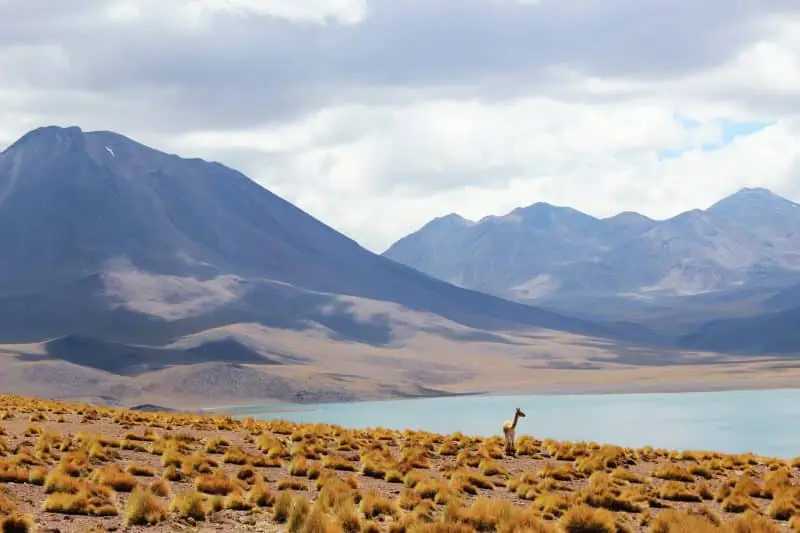Welcome to Animals and Wildlife in Chile.
Chile, a hot spice country closest to Antarctica, is known for its incredible landscapes and is situated on the western coast of South America. This beautiful country has many hidden treasures, such as its alpacas, armadillos, foxes and many more creatures! In this article, we will discuss a few of its extraordinary animal and wildlife species.
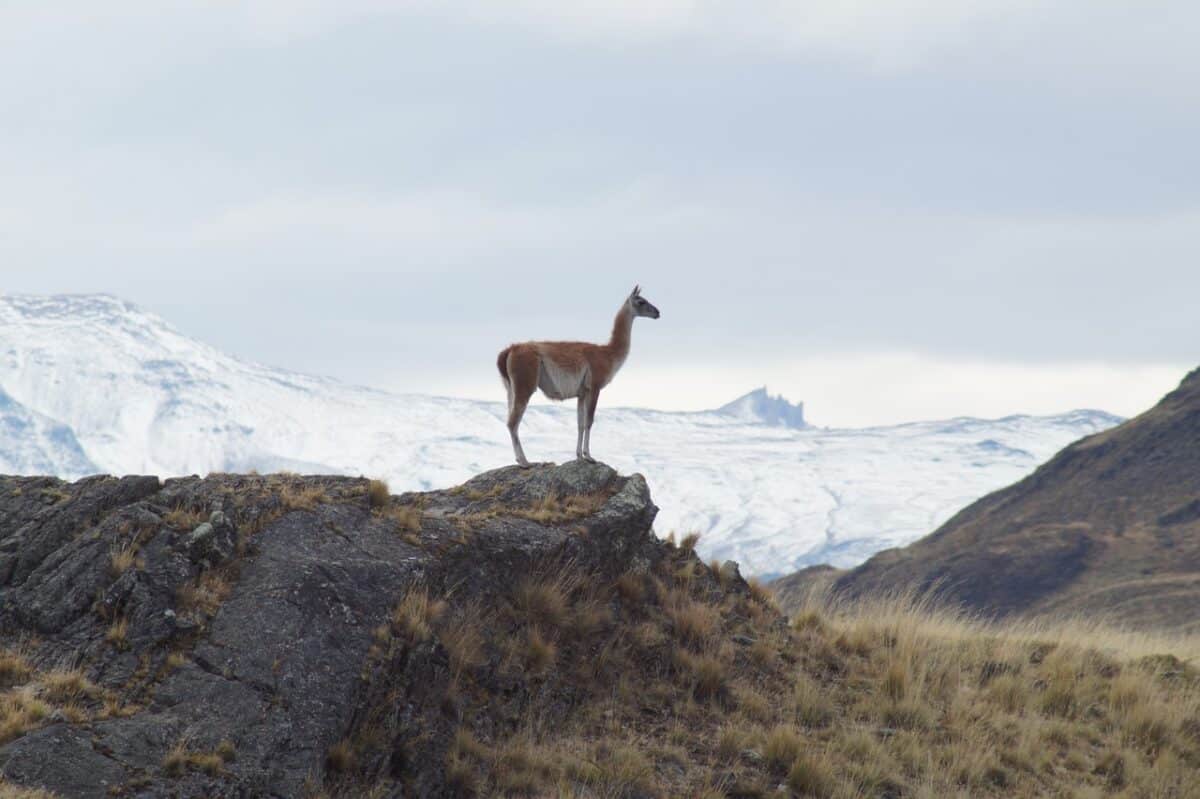
Animals that are found in Chile’s landscapes include:
- Guanacos
- Vicunas
- Armadillos
- Patagonian pumas
- And Lastly, the national animal of Chile is the North Andean huemul or taruca.
Key Points
| Wildlife Species | Description |
|---|---|
| Guanacos | – Related to camels, llamas, and alpacas – Wild animals with slender bodies, pale brown backs, and white undersides -once overhunted for their wool, now protected by law |
| Vicunas | – Closely related to guanacos and part of the camel family – Adapted to very high elevations between 10,000 and 15,000 feet – Pumas are a significant predator of vicuñas |
| Armadillos | – Barrel-shaped animals covered with natural armor – Prefer sandy or loam soils for digging and burrowing – Omnivorous diet, with 90% consisting of insects and larvae |
| Patagonian Pumas | – Largest predator in Patagonia, a member of the Felidae family – Hunt large and small animals, including guanacos, lesser rheas, rodents, and occasionally domestic livestock – Solitary hunters but have been observed sharing kills – Face threats from loss of prey, poaching, and human-puma conflict mitigation efforts are being implemented to protect them |
| North Andean Huemul | – Medium-sized deer with a stocky body and distinctive facial marking – Live in groups led by a female adult – Inhabits high-altitude rocky areas of sparse vegetation |- Classified as vulnerable on the IUCN Red List due to habitat infringement, hunting, and human settlement |
Guanacos
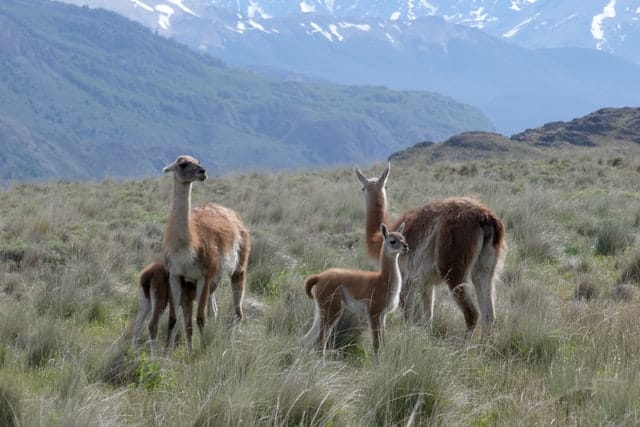
Guanacos, along with vicunas, llamas, and alpacas, belong to the camel family, despite their South American habitat, distinct from the camels of Africa and Asia. While guanacos and vicunas remain wild, llamas and alpacas have been domesticated, likely originating from guanaco breeding. These slender creatures feature pale brown backs, white undersides, short tails, large heads, long necks, and prominent pointed ears.
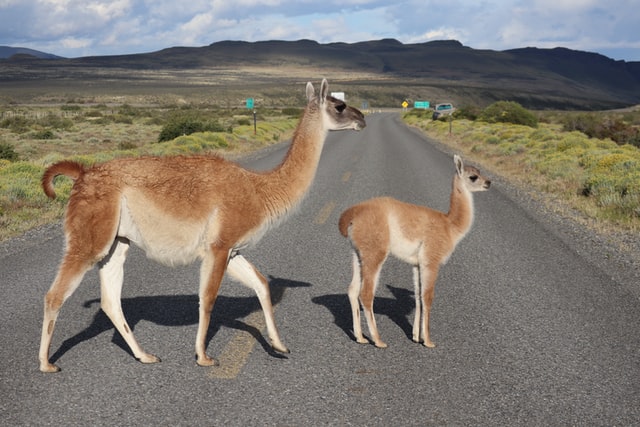
Guanacos live in groups comprising up to ten females, their offspring, and a dominant adult male. Solitary bachelor males form herds, sometimes numbering fifty or more individuals. Remarkably, when a female guanaco gives birth, the newborn, known as a chulengo, is immediately capable of walking and keeping pace with the herd.
Guanacos inhabit the lofty Andes mountains, reaching heights of up to 13,000 feet (3,962 meters) above sea level. They also occupy the lower plateaus, plains, and coastlines of Peru, Chile, and Argentina. While guanacos were once heavily hunted for their warm, thick wool, they now flourish in areas safeguarded by protective laws.
Vicunas
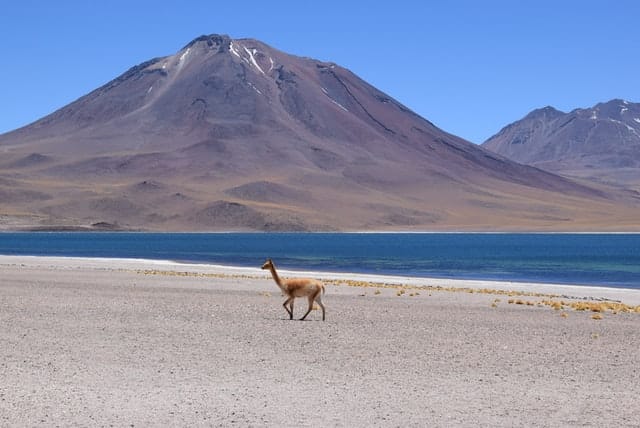
The vicuña, pronounced “ve-coon-ah,” hails from the Andes mountains and shares a close kinship with the guanaco. Despite being a member of the camel family, it’s the smallest among them. Vicuñas are about half the size of guanacos, boasting a more diminutive tail and finer wool. Interestingly, domestic alpacas likely trace their origins back to ancient attempts at taming vicuñas, making them a fascinating part of Chile’s wildlife.
These remarkable creatures call the central Andes mountain grasslands home, thriving at staggering altitudes. Most vicuñas reside between 10,000 to 15,000 feet, elevations surpassing many mountains around the world. They spend their days grazing on the grassy plains and retreat to the hills at night for safety.
In the hill and mountainous terrain, vicuñas are adept at eluding many of their predators. Their nimbleness along rocky ridges allows them to outmaneuver less agile foes. However, pumas pose a significant threat to vicuñas, as these powerful cats can capture prey even on unstable ground.
Armadillos
Armadillos are barrel-shaped animals covered with natural armor. Its name in Spanish means “little armored one.” The armadillo’s armor works well against most predators but not against cars. They are also known as the “Hillbilly Speed Bump” for their tendency to get run over by vehicles.
There are 21 species of armadillo, according to the Integrated Taxonomic Information System (ITIS). Some armadillos are very small, while others are huge. The smallest is the pink fairy armadillo, about 6 inches (15 centimeters) long. According to National Geographic, giant armadillos are the biggest species and are about 5 feet (1.5 meters) long.
These are fascinating creatures, and you can read more about them with our article on
Armadillos.
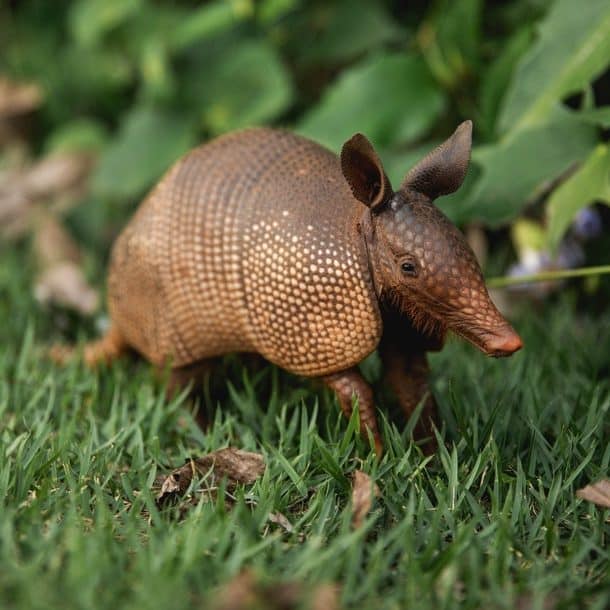
Appearance
An armadillo’s armor comprises overlapping plates covering the back, head, legs, and tail. According to the San Diego Zoo, the number of armored bands identifies the different species. Only one special species, the three-banded armadillo, can roll into a hard armored ball to defend itself against predators. Other armadillo species can quickly dig a hole, then hunker down so that their tender stomach is protected and their armor is the only thing visible.
Armadillos share close kinship with anteaters and possess distinctive features that set them apart. With pointy snouts and lengthy, sticky tongues reminiscent of their anteater relatives, armadillos rely on their highly developed sense of smell due to their poor eyesight. Wiry hairs line their sides and belly, functioning like tactile sensors, akin to the curb feelers on some cars. Additionally, armed with robust legs and sharp claws, armadillos are adept diggers in their quest for food and shelter.
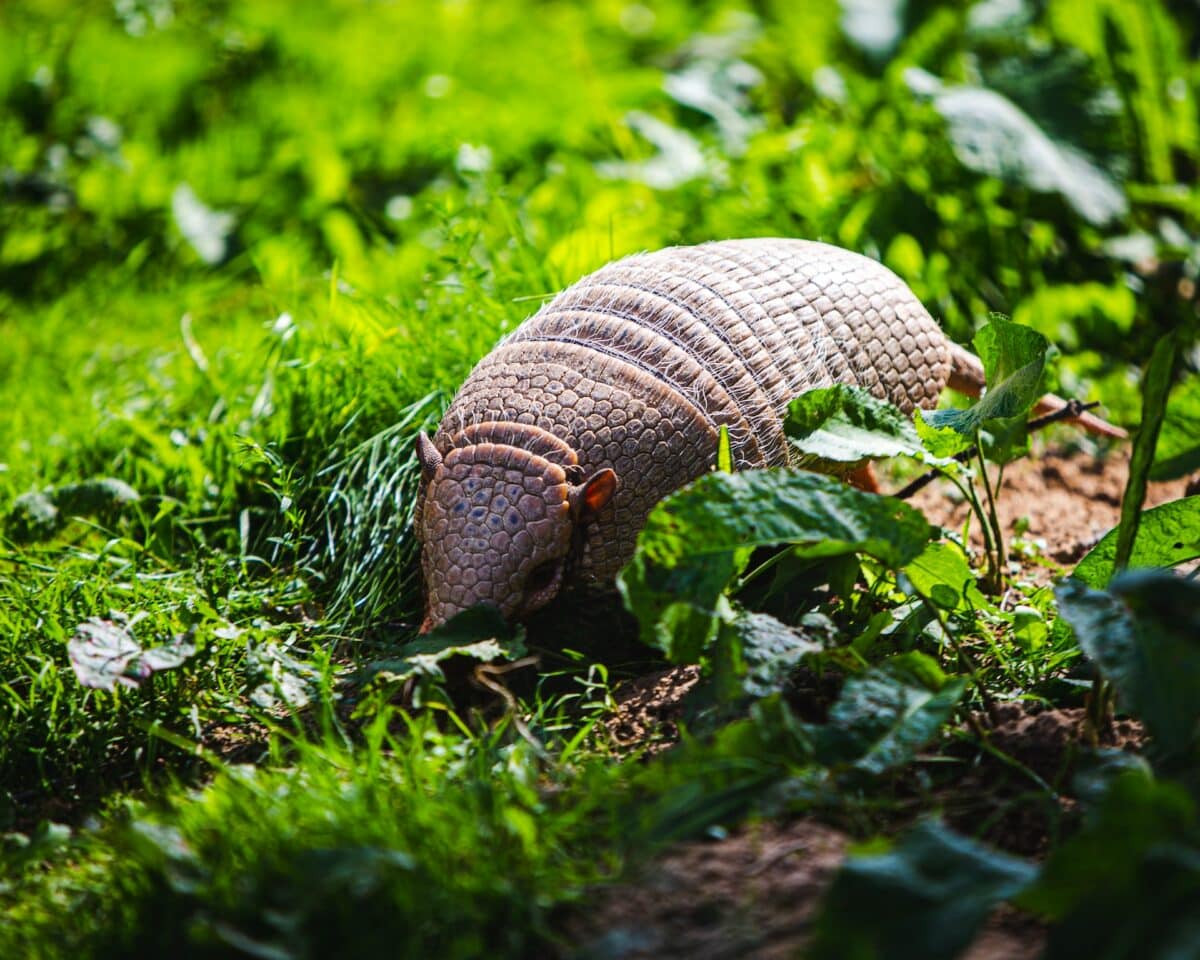
Habitat
Armadillos typically gravitate towards regions closer to the equator, favoring temperate to warm climates due to their limited fat reserves. Interestingly, their choice of habitat can be rather particular, influenced by the type of soil in the area. Armadillos tend to thrive in sandy or loamy soils that are loose and porous, as this facilitates their digging for food and the creation of burrows.
With one notable exception, armadillos are predominantly found in Central and South America. The nine-banded armadillo, as reported by the Animal Diversity Web (ADW) at the University of Michigan, stands out from the crowd. These armadillos currently range from Argentina to the southern United States, a remarkable northward expansion since the mid-19th century. They’ve even been spotted in Florida and have become commonplace in Missouri. In a striking example of their adaptability, a nine-banded armadillo was discovered in central Illinois in 2000, according to ADW.
Nap Takers
Armadillos are not social creatures and spend most of their time sleeping. According to National Geographic, they usually sleep up to 16 hours each day in caves. During the morning and evenings, they forage for food.
Usually, the only time armadillos get together is to mate or to keep warm. During cold times, a group of armadillos may hunker together in a burrow to share body heat. Sometimes, a seven-banded armadillo will share its burrow with others of the same gender.
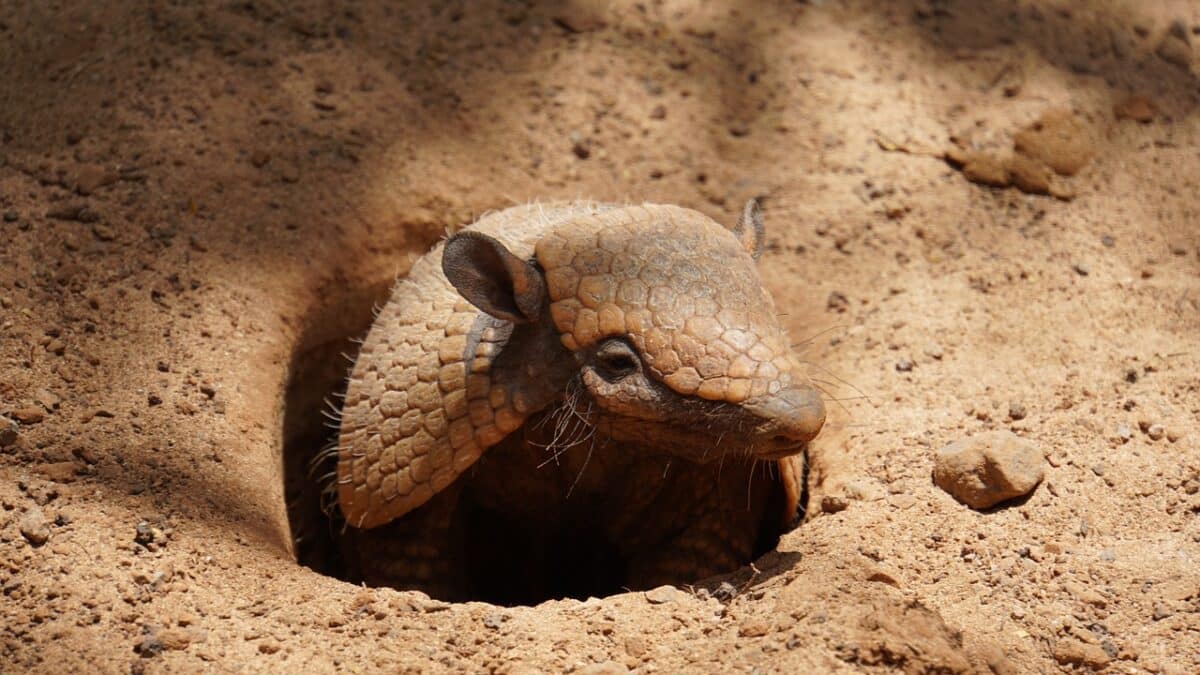
Armadillos are omnivores, which means they eat meat and plants. However, 90 percent of an armadillo’s diet comprises insects and larvae, according to the Internet Center for Wildlife Damage Management. With their long, sticky tongue, armadillos catch ants, beetles, termites, and other insects after digging them out of the ground. They also eat plants, eggs, small vertebrates, and some fruit. From time to time, they will scavenge for dead animals.
Patagonian Pumas
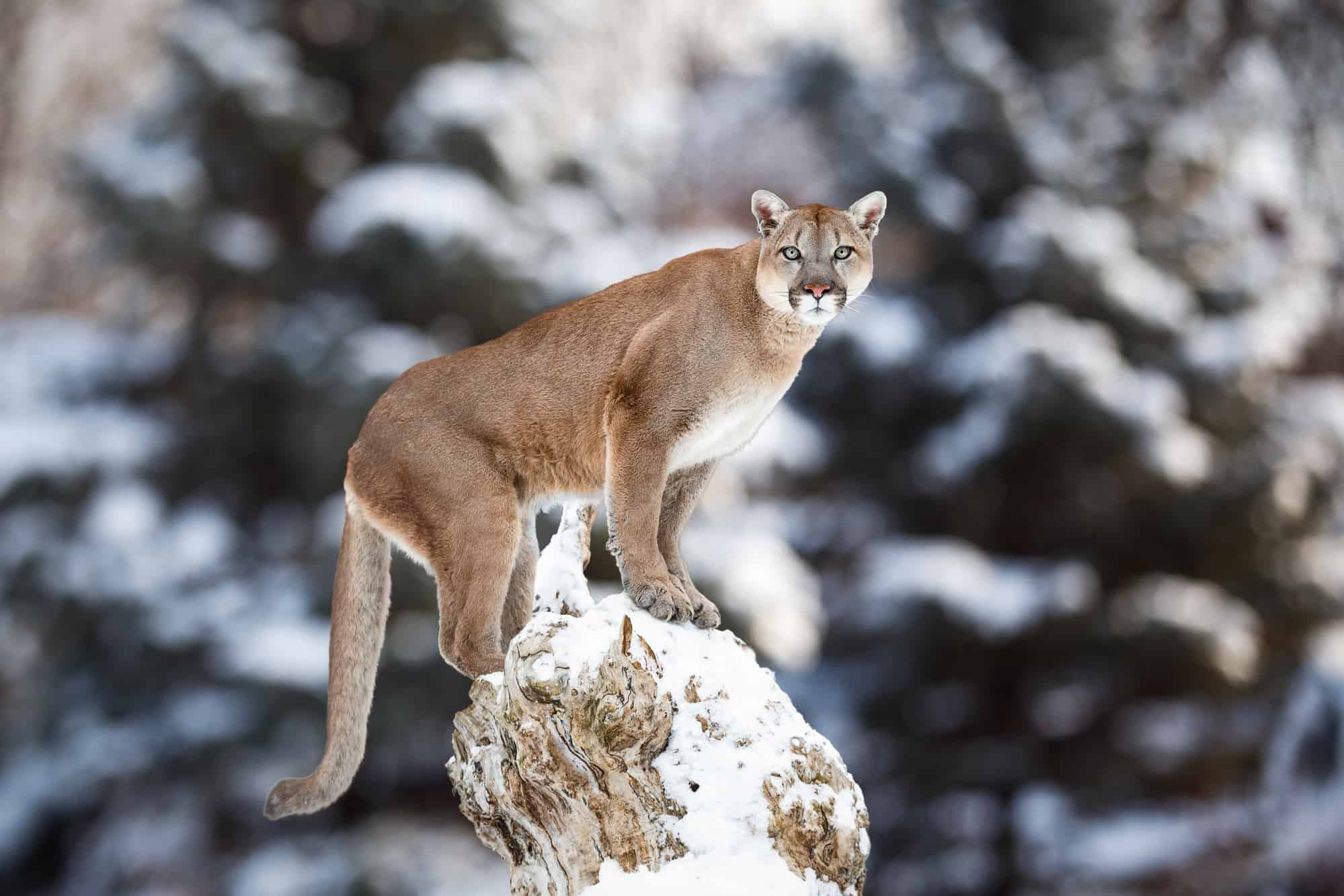
Meet the puma, a formidable member of the Felidae family, sharing lineage with the cheetah and snow leopard. As the top predator in Patagonia, males can tip the scales at around 176 pounds, while females usually weigh in at 110 pounds. These sleek felines measure between 10 to 12 feet from nose to tail.
With their rounded heads, perky ears, and powerful jaws designed for capturing prey, pumas cut an impressive figure. Their muscular bodies are accentuated by a lengthy tail, and their large forepaws feature five retractable claws, including a distinctive dewclaw. While their fur typically sports a tawny golden hue, some individuals may sport silvery or reddish coats.
Found across 28 countries in the Americas, Patagonian pumas, one of the largest subspecies, call the Chilean region from Arica to Magallanes their home. They can be encountered in shrubby steppe landscapes, dense woodlands, and mountainous terrain. Torres del Paine National Park boasts a particularly high puma density, where males and females share home ranges spanning up to 40 square miles, making them a significant part of Chile’s wildlife.
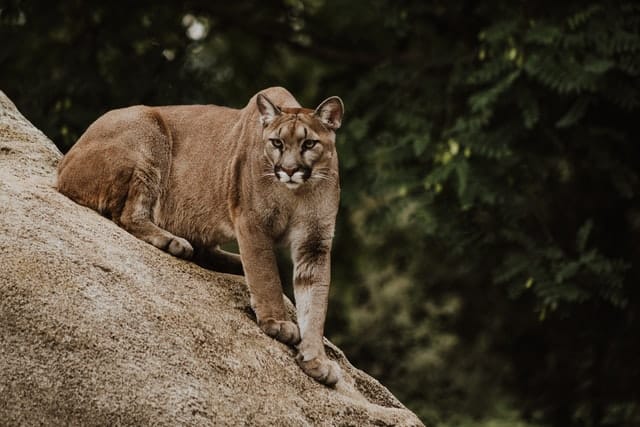
Roaming through rocky crags and dense forests, these nimble and sharp-sighted cats are masterful nocturnal hunters, relying on their keen sense of smell and hearing. Their carnivorous appetite encompasses a wide range of prey, from birds like lesser rheas and upland geese to smaller mammals such as rodents and hares, and even larger quarry like deer and occasionally domestic livestock. Among their preferred targets are guanacos, and as ambush predators, they patiently stalk their prey before launching a powerful leap and securing their meal with a lethal neck bite. Although pumas typically hunt solo, instances of them sharing kills have been documented.

Mating
While pumas, like most cats, are solitary creatures, adults come together to breed, and mothers are fiercely protective of their cubs. Females become sexually mature at 1.5 to 3 years old, and typically give birth to one litter every two to three years. During the spring, a male puma breeds with many females, leaving mothers to raise their cubs alone. After a 3-month gestation period, mothers give birth in a cave or alcove to a litter of between one and six cubs–typically two.
The blind newborns, who will open their eyes after two weeks, weigh only 1 pound. They are covered with black spots, which help camouflage them from predators and eventually fade with age. The kitten’s nurse for three months, steadily growing in size as they incorporate meat into their diet. By eight months old, the cubs are about 45 pounds and are learning to hunt under the guidance of their mother, who leads them to kill sites and teaches them to catch small prey. After two years, juveniles leave their mothers to establish their home ranges–male juveniles typically depart before females.
Threatened
A loss of prey threatens pumas in Patagonia as agricultural developments infringe on their habitat. As the guanaco’s population decreases from competing for grass with introduced livestock, pumas resort to hunting the sheep of ranchers. Pumas are often poached as a backlash for killing domestic animals. This has provoked people to create initiatives to mitigate human-puma conflict and promote co-existence between humans and local wildlife.
Solutions for ranchers include livestock guarding dogs and corralling sheep at night, and for pumas, eco-tourism may be one of their best sources of protection. The government and local businesses enforce the importance of preserving critical puma habitat when visitors invest in seeing and learning about these elusive wild cats. The Chilean government prohibited the hunting of pumas in 1980, and with the added protections in place at Torres del Paine, puma populations have risen within the national park.
North Andean huemul or Taruca
The taruca is a medium-sized deer that can grow to a height of 31in (80cm) and weighs up to 176lb (80kg). Their limbs and neck are short, and their bodies are stocky. They are identifiable from other types of deer by the dark ‘Y’ or ‘V-shaped marking on their faces, although this is more pronounced in males. Males also have antlers that can grow up to 11in (27cm). Their coat comprises thick hairs that are light to grey-brown and white underneath.
Taruca is known to live in groups of up to seven, which include males, females, and fawns. The taruca herd social structure is unique compared to different South American deer species, as a female adult leads it. They breed between June and August, giving birth to one young after a gestation period of around nine months. The female hides the fawn for the first month after it is born before re-joining the herd. Although they live at high altitudes, they generally drop altitude in winter to live in sheltered valleys.
Location
The taruca in habits the central and eastern cordilleras of the northern Andes, including highland areas in southern Peru (including Huascarán and Manu National Parks and Pampa Galeras National Reserve) and northern Chile (Lauca National Park). They are also found in northern Argentina (north of La Rioja) and in the high Andes east of Bolivia (north of La Paz and around Cochabamba).
They have been recorded living at altitudes of up to 16,400ft (5,000m) above sea level but also populate areas of Argentina that sit at a much lower 8,200 ft-10,000 ft (2,500m-3,000m). Their habitats typically include rocky areas of sparse vegetation, such as sub-alpine meadows and tundra. This explains the sandy gray coloring of their coat, which provides excellent camouflage in this environment. In Argentina, lower altitude habitats include wet forest fringes and rocky grasslands.
Although no extensive census has been conducted, estimates put the entire population of the taruca at 12,000-17,000 individuals, with numbers estimated at 1,000 in Chile (where research has been undertaken). Peru is believed to have the largest population, with the number of taruca estimated between 9,000 and 13,000.
The taruca is classified as vulnerable on the IUCN Red List. Their habitats normally infringe upon agricultural land, so they are often hunted as agricultural pests. In Bolivia, they are killed for their antlers as they are believed to be a cure for facial paralysis. Their habitats are also under intense pressure due to human settlement. Their predators include puma, Magellan foxes, and domestic dogs.
Summary of Wildlife in Chile
Lastly, I hope you enjoyed reading and learning more about Wildlife in Chile. We are passionate about Animals Around the Globe and love writing about new topics every week. Comment below if you have any blogs you’re particularly interested in reading about! Otherwise, why not look at our other blogs, like Wildlife in England or Wildlife in Colorado?
Furthermore, iIf traveling to Chile is on your radar, have a look at the tour providers below:
And Beyond the Wild Side of Chile
Thank you for reading Wildlife in Chile.
Frequently Asked Questions (FAQs)

Q: What are some iconic wildlife species found in Chile?
A: Chile is home to a diverse range of iconic wildlife species. Some of the notable ones include the Andean condor, which is one of the world’s largest flying birds. The South American gray fox, the puma, and the Darwin’s fox are also commonly found in Chile. Additionally, marine mammals like the Chilean dolphin and the South American sea lion inhabit the coastal regions, while the guanaco, a wild camelid, roams the arid plains and mountains.
Q: Are there any unique bird species in Chile?
A: Yes, Chile boasts several unique bird species. One of the most notable is the Chilean flamingo, which inhabits the country’s salt flats and lagoons. The Magellanic woodpecker, with its vibrant red head and large size, is another remarkable bird found in Chile. Other distinctive avian species include the diademed sandpiper-plover, the Andean condor, and the rufous-legged owl.
Q: What are some popular national parks in Chile for wildlife viewing?
A: Chile has numerous national parks renowned for their wildlife viewing opportunities. Torres del Paine National Park, located in the southern region, is famous for its diverse wildlife, including guanacos, pumas, Andean condors, and Darwin’s foxes. Lauca National Park, situated in the northern highlands, is known for its population of vicuñas, a type of wild camelid. Other notable national parks include Chiloé National Park, Alerce Andino National Park, and Nahuelbuta National Park.
Q: Are there any endangered species in Chile?
A: Unfortunately, like many countries, Chile is home to several endangered species. One critically endangered species found in Chile is the Chilean huemul, a deer species endemic to the region. Other endangered species include the Darwin’s fox, the South Andean huemul (a type of deer), the Juan Fernández firecrown (a hummingbird), and the Chilean crocodile.
Q: What marine life can be seen along the coast of Chile?
A: Chile’s extensive coastline is teeming with marine life. Some common marine species found in its waters include the South American sea lion, the Chilean dolphin, and various species of seals. Whales, including blue whales, humpback whales, and orcas, can also be spotted off the coast during their migratory seasons. Chile is also known for its diverse birdlife, such as the Humboldt penguin, the Peruvian pelican, and the Inca tern, which thrive in the coastal areas.
Q: Are there any opportunities for whale watching in Chile?
A: Yes, Chile offers excellent opportunities for whale watching. The country’s coastal regions, particularly in the south, are frequented by various whale species. The Chiloé Archipelago, the Strait of Magellan, and the Francisco Coloane Marine Park are popular locations for observing humpback whales, blue whales, orcas, and southern right whales. Local tour operators and specialized whale watching excursions can provide unforgettable experiences for nature enthusiasts.
Q: What precautions should be taken when encountering wildlife in Chile?
A: When encountering wildlife in Chile, it is essential to prioritize their well-being and ensure your own safety. Some general precautions to keep in mind include:
- Maintain a safe distance from wild animals to avoid disturbing them or provoking defensive behaviors.
- Refrain from feeding wildlife, as it can disrupt their natural behavior and diet.
- Observe wildlife from a distance and avoid approaching nests, burrows, or dens.
- Follow any guidelines or regulations set by national parks or reserves regarding wildlife interaction.
- If you are unsure about specific
- 5 Best Places to See African Wild Dogs - April 24, 2024
- Best Places to See Giant Pandas - April 23, 2024
- Sea Snakes: A Complete Guide - April 23, 2024

